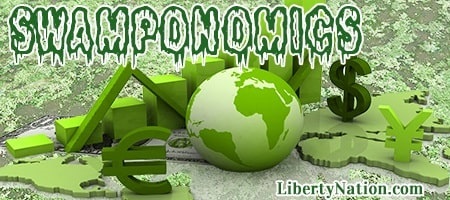Is the US economy grinding to a halt? It was quite the week in data, adding to concerns that the United States might be entrenched in a stagflation environment – a climate of higher inflation and slow growth – or heading toward a recession. When tight credit conditions and banking turmoil are added to the mix, the country might be facing a sluggish 2023. But while the first three months of the year offered some insight into the health of the world’s largest economy, the second quarter might set the tone for what the rest of the year could look like.
US Economy Slows in Q1
In the first quarter, the gross domestic product (GDP) growth rate was 1.1%, down from 2.6% in the second quarter, according to the Bureau of Economic Analysis (BEA). This was also below economists’ expectations of 2%, but it exactly mirrored the Federal Reserve Bank of Atlanta’s GDPNow model estimate, which was slashed to 1.1% the day before the official numbers were released.
Overall, the increase in GDP, which was the slowest since the second quarter of 2022, was largely driven by consumer consumption and federal, state, and local government spending.
But while the first-quarter GDP slowdown was the most notable metric, the reacceleration in inflation was also quite eyebrow-raising. The GDP Price Index – the price of goods and services produced in the US – unexpectedly climbed to 4% in the first three months of the year. This was up from 3.9% in the previous quarter and higher than economists’ expectations of 3.7%. Moreover, the Q1 personal consumption expenditure (PCE) price index advanced to 4.2% and the core PCE, which eliminates the volatile food and energy sectors, surged to 4.9%.
Despite the abysmal numbers, the White House celebrated the data, noting that the “American economy remains strong, as it transitions to steady and stable growth.” President Joe Biden said in a statement: “My Investing in America agenda is rebuilding the economy from the middle out and the bottom up, following decades of failed trickle-down economic policies.” If he thinks these are superb figures, it is not surprising why most Americans disapprove of the way he is handling the US economy.
Spending Like There is a Tomorrow

(Photo by Robert Nickelsberg/Getty Images)
It was only a matter of time before skyrocketing prices and higher borrowing costs would force consumers to hit the brakes and choose to ignore the shopping mall or Amazon. Wages have lagged inflation for 92% of the president’s term, the central bank’s rate hikes have added tens of billions of dollars to shoppers’ credit card bills, and the overall cost of living is too much to handle.
New BEA data revealed that personal spending was flat at 0% in March, down from the downwardly revised 0.1% in February. The good news was that this was better than the market consensus of -0.1%. The report showed that consumption of goods tumbled by 0.6%, caused by a reduction in spending on motor vehicles and gasoline and other energy products. The consumption of services rose by 0.4%, driven by higher spending on housing, health care, and utilities.
With elevated inflation and rising interest rates, consumers are being a bit more protective of their money. While they are still allocating their budgets to the essentials, they are refraining from spending too much on the non-essentials.
Manufacturing Nosedives
“Business has gotten stupid slow, and we estimate having many days of just a few hours’ work due to low volume,” said a printing and related support activities executive in the Dallas Fed Bank Manufacturing Index report. “This is crazy – as busy as we were last year, and now for this year to have it turn off so quickly, it is hard to understand why,” he added. “We hear from many others in our industry, and they are all saying the same thing: that it’s gotten slower without any signs of turning around in the near term. Perhaps it’s the Federal Reserve actions that are causing this.”
 Liberty Nation has documented the slowdown in the US manufacturing sector, from falling output to declining employment. Despite the billions of dollars in subsidies tossed into the Inflation Reduction Act and CHIPS Act, the manufacturing industry has been seeing a considerable slowdown. While manufacturing only accounts for about 11% of the US economy, experts say there is typically a correlation between contraction and broader recession.
Liberty Nation has documented the slowdown in the US manufacturing sector, from falling output to declining employment. Despite the billions of dollars in subsidies tossed into the Inflation Reduction Act and CHIPS Act, the manufacturing industry has been seeing a considerable slowdown. While manufacturing only accounts for about 11% of the US economy, experts say there is typically a correlation between contraction and broader recession.
The Dallas Fed Manufacturing Index plunged to -23.4 in April, down from -15.7 in March. This was the worst reading in nine months and represented the 12th straight monthly contraction. The monthly survey of general business activity for the manufacturing sector in Texas was driven by lower output, new orders, shipments, and labor. Outlook pessimism and uncertainty also accelerated.
The Richmond Fed Manufacturing Index worsened to negative ten, thanks to a collapse in shipments. Its Services Index also deteriorated to -23. The Kansas Fed Manufacturing shocked market observers after it cratered to -21 in April, down from three in March. Lastly, the Chicago Fed National Activity Index weakened to -0.19 in March, unchanged from the previous month.
Conditions in manufacturing could change in the coming months. The Biden administration has routinely touted the various investments being made by US firms and foreign companies because of the free money being tossed around. But can it be authentic growth if taxpayers are subsidizing the industry?
Please respect our republishing guidelines. Republication permission does not equal site endorsement. Click here

